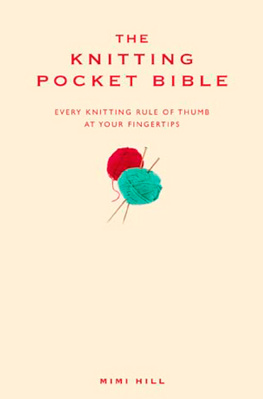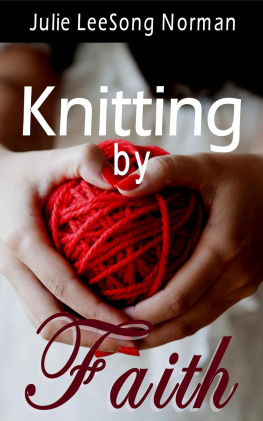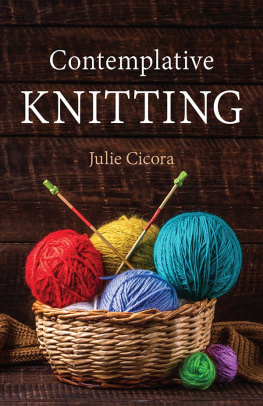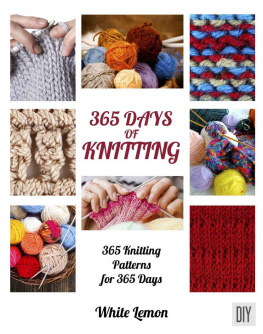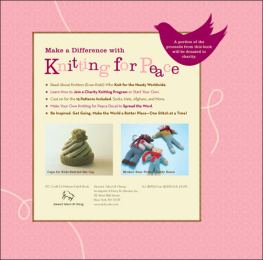Acknowledgments
W ITH GRATEFUL THANKS TO S HARON D YNAK and the Ucross Foundation for giving me a place where my imagination could roam free; to Anne Merrow, Mary Peacock, and Beth Haymaker for their heroic efforts on behalf of this manuscript; and to my intrepid agent, Susan Raihofer, who never let me rest until I had completed the proposal for this book.
Oakland, California
July 2004
A LSO BY S USAN G ORDON L YDON
Take the Long Way Home
The Knitting Sutra
 |
SUSAN GORDON LYDON is the author of Take the Long Way Home: Memoirs of a Survivor and The Knitting Sutra: Craft as a Spiritual Practice. She has written for numerous magazines, including the New York Times Magazine, Ms., Interweave Knits, and Rolling Stone, which she helped found. She has also taught knitting retreats at the Esalen Institute in Big Sur, California. Lydon lives in the San Francisco Bay Area. |
1. Animal
Comfort
F OR ABOUT TEN YEARS I 'VE BEEN GOING TO THE R USSIAN River resort area in Northern California at the end of July with my friend Lou and her family. We stay at a place called Summerhome Park, situated at a bend in the green, snaky river. Hills of redwood trees rise from its banks, and the air, carrying the combined fragrances of redwood, bay, and running river water, is so fresh and clean you wish you could bottle it and bring it home.
I sleep in the cabin with Lou's sister-in-law, Tina, and over the years a small group of what I've come to call cranky middle-aged women have emerged as a core of regular yearly guests. Besides Lou, who's been my closest friend for over a decade, and me, the group includes Tina and her longtime friend Theresa, both of them labor and delivery nurses.
Each year I watch the passage and progress of an osprey or a family of ospreys that appears precisely around the bend in the river each morning and late afternoon to fish. It announces its presence with a distinctive whistle my father taught me to recognize on one of our bird-watching trips to the Everglades and is always an exhilarating sight. I once observed the parent ospreys taking their fledgling children on a trial flight, leading them on with a fish skeleton one parent held in its mouth.
Summerhome Park is one of those resorts built in the 1920s or 1930s, when wealthy families from San Francisco went to the Russian River to summer. It is an idyllic place for children, woodsy and mysterious, with a wide, safe beach, a lodge where teenagers can hang out, buying candy and hamburgers and shooting pool, and many secluded spots along the river for canoeing, fishing, and Huck Finn-type imaginative wilderness adventures.
While the kids are hanging out at the lodge or around camp-fires on the beach, we women play a card game called Spite and Malice. It is a complicated form of multihanded solitaire. I'm sure Spite and Malice got its name from the viciously competitive way it must be played. The game's objective is to get rid of your pile of cards before anyone else does, and one way of doing it is by purposely blocking your opponents' progress. Since Tina learned it from an elderly woman she helps care for named Lucille, we call our game Lucille.
In the long, lazy evenings after dinner at the river, we women play many games of Lucille. I am a bridge player and can endure almost anything with good games of cards. I used to say that the best thing about being in jail was that there were always enough people to play cards with, and in the course of many stays in rehab, I survived by playing spades, a simpler form of bridge, with my fellows. When I was a child on Long Island, and hurricanes or thunderstorms knocked out our power and flooded the only bridge to town, my father would light candles and play leisurely games of canasta or Steal the Old Man's Bundle with the kids.
Theresa came to Summerhome Park as a child. Her aunt and uncle owned a small general and grocery store she helped out in. It had long been boarded up, though still scenic, when we discovered Summerhome Park and began to go there.
I don't know that Tina, who is goodhearted and generous almost to a fault, would describe herself as cranky. But Theresa's eccentricities would make her embrace the description wholeheartedly. Together, the four of us generate a powerful female energy that reminds me of matriarchs in an elephant or buffalo herd. I once saw a buffalo cow give birth in Golden Gate Park. The other females surrounded her in a circle of protection. That is the sort of energy we possess.
Of course I bring my knitting to the river. One year I was experimenting with luxury materials. I had begun to knit with a fiber known as qiviut that had recently come onto the commercial market. Qiviut is spun from the downy underhair of the musk ox, a shaggy Arctic beast that roams the frozen tundra and puts one in mind of a smaller, stubbier version of the woolly mammoth.
The animal is little changed from the Ice Age. According to an article by Donna Druchunas in the Fall 2003 issue of Interweave Knits, the musk ox, which was hunted nearly to extinction in the 1860s, lives in remote areas of Greenland, Alaska, and Canada, where it grows an underwool that is eight times warmer than sheep's wool. This layer of qiviut protects the animals in 100 F weather; in fact, captive herds must be protected from overheating when temperatures rise to just 70 F.
To the Yupiit people of Alaska, the animal is known as the oomingmak (the bearded one). And qiviut, the yarn spun from its soft, downy underfleece, is said to be finer, warmer, and lighter than cashmere. With each animal producing just five to seven pounds of qiviut each year, Druchunas writes, the fiber remains rare and expensive. There are cooperatives of Inuit women in the Yukon who make garments from qiviut and sell them by mail order. They are costly and exquisite. But the fiber became available for the home knitter only in the past decade, when a woman named Nancy Bender began raising musk oxen on a farm in Hamilton, Montana, and having the underfleece spun into yarn.
At about the same time, a company somewhere began producing luxurious knitting needles made of rosewood and ebony. I bought a pair of ebony straight needles with rosewood knobs and imagined myself knitting qiviut on ebony in the very height of luxury.
The needles didn't work out too well for me; the wood was hard and hurt my hands. But the qiviut worked out fine.
It was at that time available only in taupe brown, the natural color of the fleece, a color that seemed as though it would be comforting in a cozy animal way. Warmth for weight ratio is a big deal in the fiber world. Mohair, for instance, has a very high degree of warmth for its light weight, and cashmere has been coveted for years because of this quality. Of course not all cashmere is created equal. The diet of the goats, the altitude at which they are raised, the processing of the fleece, and the spinning, as well as the raw fleece itself make the feel of the fiber vary widely.
Downy fibers such as qiviut and cashmere possess what is called a halo, the fine hairs that surround the core of spun fiber and make it more or less fuzzy depending on the yarn. They are also said to bloom with washing. As the fiber absorbs water and the tightness of the spin relaxes, the yarn fluffs up and softens in an appealing way. This works particularly well with lace patterns, as the halo blooms and occupies the empty spaces formed by the yarnovers or holes in the lace.
By this point I had been knitting so much and so passionately that I had caught up with most new developments in the knitting world, had become current, as it were, and was hungry for novelty and variety.


